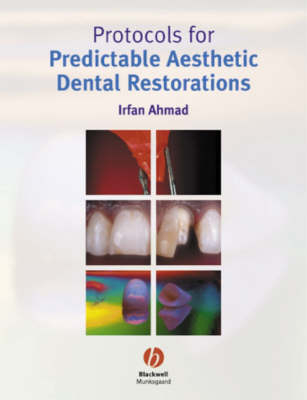
Protocols for Predictable Aesthetic Dental Restorations
Wiley-Blackwell (Verlag)
978-1-4051-1820-0 (ISBN)
The book focuses on the principles of aesthetic work across the dentist's repertoire, rather than concentrating on one particular technique. For this reason, it will add value to the range of daily restorative work in the dental surgery.
Irfan Ahmad has a private dental practice on the outskirts of London, UK. He is an active member of the European Academy of Esthetic Dentistry. He writes extensively on the topic of aesthetic restorations and is a popular invited speaker at dental conferences across the world. His publications number over 120 in peer reviewed international dental journals, and he is the sole author of two books, Digital and Conventional Photography: A Practical Clinical Manual and A Clinical Guide to Anterior Dental Aesthetics.
Dedication viii
Foreword by Ronald E. Goldstein ix
Preface xi
1 Treatment planning – assessment, planning and treatment 1
Assessment 1
Planning 3
Diagnosis 3
Risk assessment 3
Evidence-based decision making and treatment 6
Presenting treatment plan proposals to the patient 9
Treatment 11
Clinical case study 12
Assessment 12
Planning 13
Treatment 16
2 The health, function and aesthetic triad 21
Health 21
The periodontium 22
Restorative implications 29
Implants 29
Function 30
Occlusion 30
Phonetics 36
Aesthetics 37
Facial composition 38
Dentofacial composition 41
Dental composition 45
Gingival composition 48
3 Choice of all-ceramic systems 55
Scientific rationale 55
Rationale for all-ceramic restorations 55
Physical and mechanical properties of ceramic 58
Uni-layer and bi-layer all-ceramic systems 58
Aetiology of fractures 59
Dental ceramics 60
Silica-based ceramics 61
Alumina-based ceramics 65
Zirconia-based ceramics 68
Longevity 69
Metal–ceramic 69
Dicor and Cerestore 70
IPS-Empress 1 70
In-Ceram Alumina 70
Procera 70
Ceramic bridges (FPDs) 70
Clinical practice 73
4 Colour and shade analysis 77
Scientific rationale 77
The stimulus for colour 78
The illuminant 78
The object 79
Sensation (the detector) 81
Synopsis of the stimulus for colour 83
Perception 83
Tooth colour determination 85
Physical variables 85
Physiological variables 86
Psychological variables 86
Dental variables 87
Other optical variables influencing colour 89
Shade guides 90
Types of shade guide 91
Limitations of shade guides 93
Instrumental assessment 93
Spectrophotometer 94
Colorimeter 94
Digital camera and red, green, blue (RGB) devices 94
Clinical practice 94
Ocular shade assessment 95
Instrumental shade assessment 96
5 Foundations and intra-radicular support 98
Introduction 98
Vital teeth – scientific rationale 98
Vital teeth 98
Retention 99
Vital teeth – clinical practice 102
Pre-assessment for cores on vital teeth 102
Radiographic evaluation 102
Intra-oral evaluation 102
Clinical sequalae for cores on vital teeth 102
Non-vital teeth – scientific rationale 103
Post materials 103
Casting alloys 103
Prefabricated metal 103
Ceramics 104
Fibre 104
Criteria for intra-radicular post selection 106
Coronal dentine and the ferrule effect 106
Tapered vs. parallel 106
Smooth vs. serrated 107
Passive vs. active 107
Direct vs. indirect technique 107
Single- vs. multi-rooted teeth 109
Choice of luting agents 109
Aesthetics 110
Types of cores 113
Modes of failure 114
Loss of retention 115
Post fractures 115
Root fractures 116
Pre-post placement assessment 117
Endodontic factors 117
Periodontal factors 117
Choice of definitive restoration 118
Remaining coronal dentine 118
Tooth location 118
Summary 118
Non-vital teeth – clinical practice 118
6 Tooth preparation 125
Scientific rationale 125
Reasons for extra-coronal restorations 125
Biologic width 127
Margin location 128
Margin geometry 130
Preparation design 131
Maintenance of dental hard tissue integrity 133
Cutting efficiency 135
Clinical practice 135
Anterior tooth preparation 135
Assessment 136
Planning 136
Treatment 137
Posterior tooth preparation 140
Assessment 140
Planning 140
Treatment 141
7 Therapeutic temporary restorations 145
Introduction 145
Scientific rationale 145
Health 145
Function 147
Aesthetics 147
Biocompatibility 151
Strength 151
Palliative 151
Marginal integrity 152
Preventing plaque accumulation 153
Chromatic stability 155
Handling characteristics and ease of fabrication 155
Material selection 155
Polymethyl methacrylate (PMMA) 156
Polyvinyl ethylmethacrylate (PVEMA) 156
Bis-GMA resin 157
Bis-acryl resin composite 157
Urethane dimethacrylate (UDMA) resin 157
Clinical practice 157
Fabrication 157
Matrices 158
Existing anatomical form 158
Proposed anatomical form 158
Preformed metal and plastic crown forms 159
Techniques 159
Direct technique 160
Indirect technique 162
Direct–indirect technique 162
8 Biological impressions 165
Introduction 165
Scientific rationale 165
Secondary determinants 166
Stock vs. custom trays 166
Inter- vs. intra-arch 166
Closed vs. open tray 167
One vs. two stages 167
Passive vs. non-passive 168
Warm vs. cold environment 168
Manual vs. automated mixing 168
Physical vs. chemical gingival retraction 168
Impression materials 169
Primary determinant 172
Patient factors (risk assessment) 173
Operator factors 174
Clinical practice 177
Dental biological impressions 177
Gingival biological impressions 179
9 Try-in procedures 185
Clinical practice 186
Extra-oral evaluation 186
Inspection of restoration on trimmed die 187
Inspection of restoration on untrimmed die 188
Intra-oral evaluation 189
10 Cementation and dentine bonding agents 191
Scientific rationale 191
Types and properties of luting agents 191
Zinc oxide eugenol (ZOE) 191
Zinc phosphate (ZP) 192
Polycarboxylate (PC) 192
Glass ionomer (GI) 192
Resin-modified glass ionomer (RGI) 192
Dual-polymerisation resins (DR) 192
Self-adhesive, dual-polymerisation resins (SADR) 192
Self adhesive, auto-polymerisation resins (SAAR) 193
Ceramic primers (CP) 193
Efficacy of cementing agents 193
Adhesion 193
Occlusal stresses 194
Marginal integrity and leakage 195
Retention 196
Pre-treatment of abutment 197
Dentine bonding agents 197
Efficacy 201
Pre-treatment of intaglio surface 202
Clinical practice 203
Index 211
| Erscheint lt. Verlag | 3.3.2006 |
|---|---|
| Verlagsort | Hoboken |
| Sprache | englisch |
| Maße | 191 x 246 mm |
| Gewicht | 572 g |
| Themenwelt | Medizin / Pharmazie ► Zahnmedizin |
| ISBN-10 | 1-4051-1820-2 / 1405118202 |
| ISBN-13 | 978-1-4051-1820-0 / 9781405118200 |
| Zustand | Neuware |
| Informationen gemäß Produktsicherheitsverordnung (GPSR) | |
| Haben Sie eine Frage zum Produkt? |
aus dem Bereich


